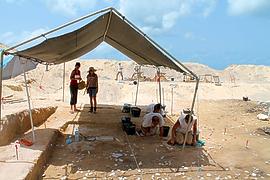Source - http://thedailyherald.com/index.php/islands/1-islands-news/41459--new-archaeological-site-unearthed-in-long-bay.html

Archaeologists from Institut National de Recherches Archéologiques Préventives (INRAP) are currently studying a pre-ceramic Amerindian site on the beach in Long Bay.
The team of 12 archaeologists led by Dominique Bonissent has been working since the beginning of July and expects to be finished by August 23. The site is on a sand bar next to a building site and a great deal of sand had to be excavated to expose the artefacts. French law requires that an area suspected of containing artefacts be excavated and items collected before any construction can begin.
Bonissent confirmed the diagnostic survey indicated an area rich in shell resources.
"These were nomadic people travelling in canoes who would have come to this area because of the abundance of shellfish, types of clams, conchs, etc.," Bonissent told reporters. "There are three main areas of shells that indicate they were here just for cooking and consumption. There are very dark areas of ash and charcoal too from the fires they lit to cook the shells. But, we haven't found anything to prove how they lit the fires, with stones or wood.
"When the resources were depleted they would move on, but return to the site at a later time. We don't know the exact date of the site because we haven't sent any samples yet to be dated. And under this level is another site from a different earlier occupation."
She noted in 2002 at the east side of Long Bay she found another pre-ceramic occupation at a smaller site of shell resources dated 1500 BC. Other pre-ceramic sites have been found at Baie Rouge and Orient Beach. The Indians would move about according to the location of the best resources, favouring French-side beaches for the easier access.
"In the ceramic period, they would make a hole in the conch and extract the animal before taking just the meat to the village to be cooked, as opposed to the pre-ceramic period when the whole shell was cooked on the fire," she explained.
The site is not open to the public and no open day has been planned.